Trekking in the Langtang-Gosainkund Region of Nepal 31 Oct-16 Nov 06

The trails of the Langtang-Gosainkund-Helambu region of Nepal are less visited than the more popular circuits of Annapurna and Everest Region. The few trekkers that we encountered on the trail were mostly Germans and a few French, and I met no other Malaysians. Nevertheless, we had a rich and exciting experience.
31 Oct 06 - Kathmandu : a first impression
Arriving at Kathmandu's Tribhuvan International Airport at 12.15pm, five minutes ahead of schedule even though the Royal Nepal Airlines plane did not lift off from the Kuala Lumpur International Airport until 8.20am. when it was scheduled to be 7.30am., the unimposing ochre facade of the arrival terminus looked cold and unwelcoming. The sole Malaysian amongst a plane-full of Nepalese returning home from their employment stint, I followed them to clear immigration and custom. The terminus was rather quiet, a few unsmiling workers and airport officials saundering about leisurely and observing us with stern faces. The small immigration hall was packed, every queue seemed to be hardly moving as the officials took their time to verify your visas. After an interminable 40 mins. my passport was handed to me by the stone-faced officer unresponsive to my "thank you".
Mr. Shankar Pathak, the director of Exotic Mt. Treks, was waiting with my name on an A4-sized typing paper. Finally a smile, as he greeted me and I introduced myself. It took less than 25 mins. to make our way to the Harati Hotel at Thamel where my two trekking buddies had already checked in on Sun. 29 after completing a 21-day Annapurna circuit. At dinner my two companions regaled me with their exploits and those of four other friends who left on the same day I arrived. Seemed that everyone had experienced a degree of mountain sickness as they made their way up to the Thorung La Pass (alt.5410m). A lady friend made it on horse-back, but made poorer by RM150.
Thamel, with myriads of shops and pot-holed "streets" devoid of pedestrian pavement is the part of town where tourists find accommodation. The streets were no wider than the back-lanes in Kuala Lumpur's Chinatown. Kancil-sized Suzuki Maruti taxis with overworked horns, blared to shoo away motorcyles, bicycles, rickshaws, cows, dogs and pedestrians. A first-timer stood well to the side, wondering how to make his way in this labyrinthian chaos. We walked to the trekking agency, Exotic Mt. Treks, to make plans for the next two weeks of trekking. It was decided that the better option would be a 12-day "moderately difficult" trek to the Langtang-Gosainkund-Helambu region. After dinner we made our way back to the hotel, even the short distance had us covered us with a fine layer of dust, my mouth dry and nose beginning to run.
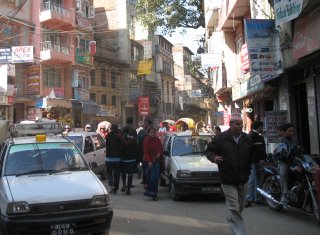
1 Nov 06 - Kathmandu to Syabru Besi alt. 1460m : Hair-raising bus ride
Starting out at 6.30am to the bus station, the sun was already bright and temperature in the low 20s deg C. Nepal's time-zone is 2 hours different from Malaysia. Our guide was Dev Lal, aged 29 years, a Tamang from the Rasuwa province who could speak a fair bit of English. The three "senior citizen" trekkers, shared a porter, Chumpa, aged 25 years, who spoke a smattering of English haltingly.




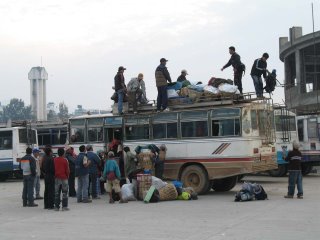
While we were having breakfast at the station, our guide and porter took our backpacks to the top of the rusty, woebegone bus. This was the only bus service to Syabru Besi, from which our trekking would begin. The journey began at about 8am. The seats had thin cushions and there was hardly any room to stretch your legs. As the bus vented protests on the steepening pebble-strewn pot-holed road, I silently chanted a mantra for a safe passage.

At 12.40pm the bus had to stop and all passengers disembarked to pay their dues to the "United Revolutionary People's Council", Tamang Autonomous Republic State, Rasuwa. The tax was Rs100 per day of trekking so we paid up Rs1200 each (RM60,USD1=Rs71). A white couple tried to pay less as they reasoned with the Maoist militia men that they were trekking only part of their stay. This attempted negotiation, which attracted a crowd of locals, took more than half an hour with the couple finally having to accede to full payment for their entire stay. Such an exercise in futility, the militia men were armed, the bus was half-way on its destination, no one could tell when a bus would return to Kathmandu which was five hours away.
At 4.00pm we reached Dhunche, another check-point, this time to show our Trekking Registration Certificate (TRC). Our trekking operator had applied and paid the Rs250 per trekker on our behalf. At this check-point we had to pay a further Rs1,000(RM50) for the Entrance Permit to the Dept. of National Parks & Wildlife Conservation. A young white man who had no TRC was refused entrance and told to return to Kathmandu. While the rest of the passengers waited he finally boarded the bus after another half an hour's delay, how he solved his dilemma was unknown to the rest of us.
Finally we reached Syabru Besi (alt. 1460m) at 6.15pm, night had already fallen, the few street lights dimly lighting one main street. It took nearly 10 hours for the 135km. journey.
Despite the tiring ride and tiresome behaviour of some local passengers who had no appreciation for personal space, the trip had its exciting moments. The bus would stop wherever there were passengers to be picked up along the way, however crowded the bus. Villagers would heave their farm products and occupy every inch of the aisle. Passengers who could not find a place to stand cheerfully sat on the budging sacks. Not a problem if they could not squeeze past the door, up they climbed on the roof. Half expecting chickens and goats to be brought abroad, my anxiety was dazed as the bus zigzagged on the edge of the highland. If you peered down the window, oftentimes the edge of the road was not visible, a vista of verdant terraces of millet and maize hundreds of metres below greeted you.
Occasionally, another vehicle loomed head-on and the bus would stop. One vehicle would manoeuver by reversing or edging to the side of the hill while the other inched slowly pass. Should the bus be on the outer edge and its wheels too near the precipice, the alighted conductor, a boy in his teens, would slammed hard on the bus to warn the driver. As the bus lurched from side to side, we passed sign-posts alerting of rock slides. Boulders balancing precariously on the upper edge of the hill seemed to grin fiendishly. And just as I was about to doze off, a loud banging on the roof announced a passenger's wish to alight.
It was a splendid beginning.
2 Nov 06 - Syabru Besi to Lama Hotel, Changtanga, alt. 2490m.
Loud horns broke up my fitful sleep. I looked at my watch and it was 5.45am. The bus stop was right in front of the Lhasa Hotel where we had put up the night. Unable to get back to sleep I packed my stuff and had an early breakfast. Starting out before 8am along the main street of Syabru Besi, the road narrowed to a foot-path as we crossed the Bhote Kosi Bridge at road end, the first of many suspension bridges. Eyes gazing at the splendour of the distant mountains and a jaunty walk blurred the awareness of time. We stopped for lunch at the Bamboo Lodge, alt. 1970m, at 11.20am. Vegetables, organically grown, were plucked from the garden at the back of the lodge and freshly cooked.

While we waited for our meals to be cooked, we admired the Lantang Khola Range that loomed above us and, further afield, the Ganesh Khola Range, all the time imbibing fresh mountain air. The local highlanders work unhurriedly so it was well past an hour before our lunch was ready and we resumed our journey.
After every hour of trekking we came across a tea-house or lodge. A hot lemon tea and hot-water ("tatok pani") which cost Rs50(RM2.50) would increase to Rs90 (RM4.50) the further up we went.
We often met porters carrying bulky provisions that weighed more than 45kgs. We moved aside in order not to impede their pace. They wore slippers, only a few had canvas shoes (mostly, woman porters), the burdens at their backs supported only by a stout strap that crossed their shoulders to the foreheads. Occasionally, we encountered a porter carrying 7-foot long sawn-logs. Wherever the path was too narrow for him to pass he would walk sideways. Seeing such hardiness and perseverance, the ache from my arthritic knees paled in significance.
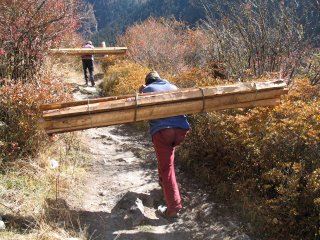
At about 3pm. we reached Lama Guest House, alt. 2490m. It took us about 7 hrs. to cover a distance of 12kms. with a gain of slightly over a 1000m. height.
3 Nov 06 - Changtanga to Langtang Valley alt. 3250m.
Refreshed from a long sleep we headed towards Langtang Valley, about 14kms. away. Our guide told us that our trail today, though long, would be less steep. It was pleasant to hike through pine and fir forests in the autumn, the soft ground covered with golden leaves and a gentle breeze wafted upon us. The trail was indeed more gradual, a welcome respite from the several stretches of 60 deg. gradient that we had to climb yesterday. Often as we walked, the faint sound of distant thunder from mighty waterfalls grew louder as we came across white-frothed waters rushing down rapids.
Mid-way, as I passed a villager's house a man called out for "medicine". He had a toddler with eyes and a ear infection. I wanted to treat the little boy with antibiotic eye-drops, but to my chagrin, remembered that my first-aid kit was with the porter who had gone well ahead of me. I gave several package of biscuits to the boy and some money to the father. Dev translated my intention to give him the antibiotic for his child on my return trip.
At 3pm. we reached the Hotel Langtang View Lodge, alt. 3250m., so again it took us about 7 hrs. Langtang valley, with the towering mountains of the Ganesh and Langtang Himalayas clearly visible, was as picturesque as a postcard. Horses and "dzomos" (shorter-haired crossbreed of yak & cow) were grazing contentedly. The people in the village are Tibetans who have migrated here several generations ago. Did their intrepid forefathers crossed the colossal Shishapangma alt. 8010m., so close from where I stood?
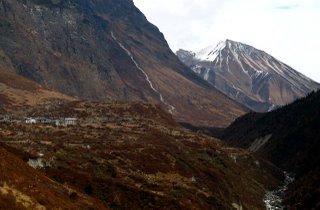
We greeted fellow trekkers and locals alike with "Namaste" (literally "I salute the god in you"), a universal greeting that never failed to bring forth a smile.
4 Nov 06 - Langtang Valley to Kyangjin, alt. 4100m
Today we headed for Kyangjin Gompa, though only about 7km. away, rose steeply to 3900m. As usual we started out at about 8am. and reached the View Point Guest House at 11.15am. After lunch and a short rest we trekked to the Yongsa Tenjin Glacier, alt. 4100m., stopping for a while at a gompa (a Tibetan shrine) where I bowed my respect before the image of the Lama who had died a few centuries ago. After putting a small donation into a box for the upkeep of the shrine we took leave.

The trail to the glacier was difficult with pebbles and stones of diverse sizes obstructing our way. It was a steep ascent up a gradient of 60 deg. and we finally reached the foot of the glacier at 3.40pm. It being the first time I set eyes on a glacier, this "river of ice" was cold and imposing, somewhat threatening, tolerating no one as it moved down the mountain. Cold clouds were rapidly rising around us, so we did not stay too long. I was quite exhausted when we finally reached our lodge at 4.30pm, with a headache and running nose. By dinner time, the headache worsened and I had no appetite.
My companions were worried that I might be suffering from high altitude sickness. The classical symptoms of fatigue, headache, loss of appetite were certainly felt by me. In three days I had ascended from 1460m to 4100m, insufficient time for proper acclimatisation. As a rule of thumb, beyond an altitude of 3000m. it is inadvisable to ascend more than 300m. for each day of trekking, so the ascent to the glacier was a foolhardy act.
I retired early but the throbbing headache robbed me of a good rest.
5 Nov 06 - Kyangjin to Lama Hotel alt. 2490m
The next morning, after consuming hot soup of ginger & garlic, I felt slightly better but was in no condition to proceed up to Tserkori Peak at 4980m. We decided to back-track to Lama Hotel.

On the way back, I remembered about the child with infected eyes. Unfortunately, the house was empty. Dev explained that during the day whole families worked in the fields, the child would be brought along too. I felt sad that an opportunity to perform a good deed had passed me by.
We had lunch at the Hotel Tibetan, Ghoda Tabeta alt. 3048m. The menu is the unchanging standard fare of dhal-bhat (boiled rice with lentils, vegetables and spicy pickles), fried rice/mee or souped noodles. Highlanders do not slaughter their cows and chickens to cater to tourists, how else would they get their regular supply of milk and eggs?
A consequence of being an enforced vegetarian, eating dhal consecutively for several days, had the alarming effect upon me of a "gassy" stomach. Throughout the days of trekking, I trailed behind my companions, partly because of aching knees but more to do with the embarassment of constantly breaking wind. Dev, our guide duty-bound to walk behind me, never had much chance of breathing fresh mountain air.
The return trip to Lama Hotel was in good time, retracing the 21-km. descent took us only seven and a half hours. At 3.35pm. we settled down at the hotel, my headache miraculously disappeared.
6 & 7 Nov 06 - Lama Hotel to Thulo Syabru alt. 2230m
Occasionally spotting an eagle high overhead, we passed by many waterfalls. So far it was an easy descent, but not for long. We stopped for lunch at the Landslide Hotel, alt. 1700m. A short distance later after crossing a suspension bridge the trail would turned upwards, on a steep 55 deg gradient until we reached Thulo Syabru, alt. 2230m., at about 5pm. It was a long 10km. trek, though not difficult, the eight and a half hours journey was tiring.

Thulo Syabru was the largest village during our trek. There were more houses than in Langtang Valley, densely packed on a mountain slope, with verdant terraces of millet, maize and wheat, and pockets of vegetable plots. The men were busy tilling the terraces with buffalos pulling wooden ploughs while the women winnowed grains, and children happily skipping down the slopes with winged feet.
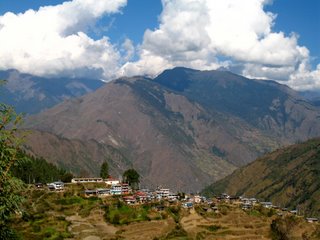
There was a wooden-structured "school" perched on a higher terrace. It seemed to have only one dark and gloomy classroom without lights, no black-board and only a few chairs and desks. Instead the teacher and children preferred an "open class" out in the field, sitting on the ground, basking in the sunlight.
We decided to stay here for two nights to rest, giving me time to further acclimatise before we reached for greater heights.
8 Nov 06 - Thulo Syabru to Sing Gompa, Chandanbari, alt. 3250m
It was a lovely morning, with a clear blue sky, as we set forth for Sing Gompa. As we trekked higher we were enchanted by panoramic views of the Gosainkunda Range of the Himalayas. It was delightful to pass through the pine and fir forests with their golden carpet of fallen leaves welcoming us once more .
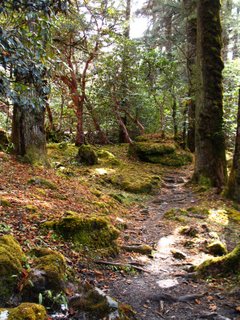
Though it was a relatively short distance of 6km. we covered more than 1000m. in altitude, so it took us about six and a half hours to reach Sing Gompa. This was a small village of less than ten houses, three of which were guest houses and a "factory" making yak cheese. We bought some and it was delicious.
We stayed at the Lhasa Lodge, run by a young couple with a toddler and an 8-year old girl. The little girl was quiet and very hardworking. When we woke up at 6.30am. she was already busy helping with collecting fire-wood and dried cow-dung (for fuel), performing household chores and baby-sitting the toddler. In this part of the highland there was no school and children learned to deal with the harshness and poverty at a very young age.
There was no electricity, like most lodges in the mountains, with the exception of Thulo Syabru & Langtang Village getting power from a mini hydrostation. A small solar panel provided hot water for bathing and the power, stored in a lead-acid battery, provided enough electricity to run a video recorder and a tiny black & white TV. After dinner the family, our guide and porter were glued to the TV watching a VCD Bollywood movie, while I gazed out at the window watching the swirling clouds bringing rain for the first time since I started out from Kathmandu.
9 Nov 06 - Sing Gompa to Gosain Kunda, alt. 4360m
Bracing ourselves for the most difficult passage, we passed through a frost covered trail. Stunted shrubs and mosses replaced pine trees at this altitude. The view of the Gosainkund Range at Lauribinayak, alt. 3925m, was superb, the Himalayas seemed to embrace us. We had lunch here and spent greater than an hour admiring the panoramic view.

As we passed Lauribinayak we had to ascend a steep pass, the Saraswoti Kunda and Bhairab Kunda (lakes) far below us on our right. Finally, we got sight of Gosain Kunda, the lake sacred to Hindus and Buddhists. This holy lake is visited by the thousands during a full-moon festival in August every year for a ritual bath. It was now mid-autumn and the water was icy cold, the place was deserted and the nearby shrine neglected and derelict.

We put up for the night at the Peaceful Lake Hotel, alt. 4300m. It was bitterly cold at night, below zero degree. None of us braved a shower and we woke up to a frosty morning.
10 Nov 06 - Gosain Kunda to Sing Gompa
Our original itinerary was to trek through the Lauribina La Pass (alt. 4600m), then to descend to the Tharepati Pass (alt. 3600m), Kutumsang and Chisapani (the region known as Helambu, home of the Sherpas). This had to be aborted because the trail was snow covered at the high pass and we were not equipped for trekking in snow.
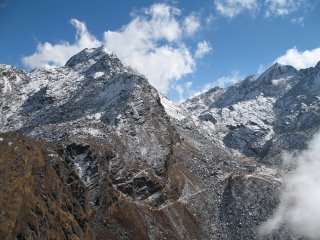
After breakfast we retraced our way, passing Cholangpati alt. 3680m. at 10.40am. and once more arrived at the Lhasa Lodge, Sing Gompa, before noon. The greater part of our trekking having been accomplished, we relaxed and absorbed the mountain atmosphere. In the evening, around the wood-fire stove, the three buddies chatted cheerfully, soaking in the warmth of companionship and entertained ourselves with traveller's tales.
11 Nov 06 - Sing Gompa to Dhunche, alt. 2030m
We said our goodbyes to the young caretakers of the lodge. I presented USD10 to the adorable girl, her industriousness belied her tender age, a silent prayer for her in my heart as I stepped down the stairs.

During the 6km trail to Dhunche, I was at times invigorated by the friendly forests, then knee-wrenched by steep rocky descents. The trail meandered gradually to cultivated land. Dhunche is quite a busy little town with small shops, rural banks and government offices built along the main road. There is electricity in this town. At last, a leisurely hot bath at the Himalayan Legend Hotel, without the water turning cold and petering out.
12 Nov 06 - Dhunche to Kathmandu
We braved ourselves for the return trip to Kathmandu in the same kind of seemingly rickety but amazingly robust bus. My expectation to have a less discomforting ride this time, Dhunche being a shorter distance by 3 hours to Kathmandu, was dashed as my seat at the rear, just above the wheels, vibrated and jostled upon moribund or missing shock-absorbers. A more experience rider this time around, gritted his teeth as passengers began to pile into the bus and on the roof. Mercifully, my silent mantra chanting was rewarded with a smaller crowd.
In spite of a numbed rump and what remained of my dislocated anatomy, I kept my bodily parts intact and reached Kathmandu at 3.15pm.
13 Nov 06 - Shopping in Thamel
Now settled back luxuriously in Hotel Harati, we behaved like good tourists by visiting the "must-see" attractions and shopping for cheap bargains.

My intial poor impression of Thamel was tempered with more tolerance, now that I had accomplished my mountain excursion. Less intimidated by the traffic pandemonium, I foraged for bargains in the maze of shops. I bargained to a third of the price not to be daunted by the shopkeeper's supplication to my goodness.
14 Nov 06 - Visit to Patan
Patan (its older name is Lalitpur), only an 8-km. drive to the south of Kathmandu by taxi, is "the city of fine arts". It boasted of having the most number of talented artists and finest craftsmen. The artistic and magnificent architecture of heritage buildings such as the Hiranaya Varna Mahavihar (Golden Temple) dedicated to Sakyamuni Buddha, Khrishna Mandir Temple, Jagatnarayan Temple of Lord Vishnu, Kumbheshwor Temple of Lord Shiva and the numerous monuments in Patan's Durbar Square is testimony to their exquisite skills.

The ubiquitous souvenir stalls somewhat diminished the spiritual and devotional atmosphere of the sacred temples. Occasionally, we were approached by salesmen hawking "singing brass bowls", silver bells, bamboo flutes, brass and stone figurines of Buddha and Lord Ganesh. We just smiled and if we did not reply to their offers, they would leave us alone.
There are also many small shops, scattered in and around this city, that displayed Tibetan carpets, Thangkas and intricate Mandalas (paintings with religious significance on cotton canvas), silver and gold jewellery embedded with colourful gems, large bronze images of Buddhas and Bodhisattvas, modern water-colour and oil paintings of pastoral scenes, Himalayan mountains and Hindu deities. The articles on sale here were of a higher material quality and looked more finely crafted than similar ones that were found in Thamel.
15 Nov 06 - Visit to the Bouddhanath Stupa
The Bouddhanath Stupa is revered by Buddhists in Nepal as one of the most holy sites. About 7km. east of Kathmandu, it is also known as Khasti Chitya and is considered as one of the oldest stupas and largest (height of 40m., diameter of 100m) in Nepal. Its dome-shape has a circular path at the bottom and another path above on three tiers. The top tower is capped with a great pyramid and the most prominent feature above is the "all seeing eyes" of the Buddha painted with red, white and blue. Prayer flags are draped from the top of the monument and fly in the breeze.
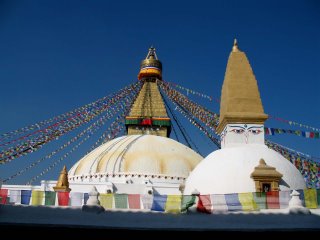
It is believed that King Manadeva built the Bouddhanath Stupa during the Lichavi period, between about 400 and 750AD . It has been renovated on numerous occasions and the present form of the stupa was laid-out in the 17th century.
We came on a festival day and there were thousands of devotees who congregated here to hear the Dharma Talks given by Lamas (Lama translates as "superior one," is a title officially extended only to the few dozen Tibetan Buddhist monks who have achieved the highest level of spiritual development) and Rinpoches (Rinpoche literally means "the precious one in human kind", title reserved for incarnate lamas). Just beyond the stupa there was a huge tent erected to provide shade, and several hundred devotees were seated on chairs beneath listening attentively to their teachers. Those who could not be seated were standing on the periphery while others were making offerings in the stupa.
The main stupa was closed to visitors today because of the festival, only a small area was opened for devotees to make offerings at the main entrance. So the interior of the stupa remained mysterious to me, and I could not see for myself the pinnacles as well as the 108 Buddhist Gods and Goddesses that were mentioned in tourist brochures. Walking round the dome I was quite disappointed, the circular structure was completely painted a glaring white on the exterior and looked nondescript unlike the Hindu Temples of Patan.
Besides the stupa, the outlying area of Bouddhanath is bustling with traffic and the din of street merchants. After 1959, many Tibetans came and have settled in the Bouddhanath area.
16 Nov 06 - Flight home
Our last day in Kathmandu was spent window shopping around the Thamel area. Having busted our budget, we were counting our last dollar and cents. We managed to get Shankar to talk to the hotel manager to allow us to stay until 6pm. at half the usual room-rate. So we were well rested when we left for the air-port at 7.45pm.
It was a crowded scene at the departure hall. Hundreds of Nepalese were already sitting on the floor, in front of two, as yet unopened, Royal Nepal Airline counters. A much smaller queue, of mostly white tourists, was waiting at the Anzac Alliance counter.
We paid Rs1130 (RM56.50) for the "Passenger Service Charge" and another Rs565 (RM28.25) for "Tourism Service Fee". However, service was really poor, there were insufficient chairs for visitors to sit and only 2 small sundry shops were opened. It was a long wait before the 2 counters were opened at about 9.30pm. and, thankfully, another two more counters were opened when the two queues hardly seemed to move. The lack of service was again obvious at the security check, only one x-ray machine for two plane-loads of passengers was in operation even though there were two other machines standing idly.
To make matters worse, the security check was extremely stringent. Passengers were asked to remove their shoes and belts, their check-in bags were emptied for scrutiny (what was the X-ray for?). Having being cleared, there was another long wait to board the plane and the locals rushed at the entrance when boarding was allowed just half an hour before departure time at 11.30pm. The plane lifted off at 11.45pm, surprisingly only 15 mins. late considering the unruly crowd. The plane arrived on schedule at KLIA at 6.05am.
Summary - Second Impression
I am extremely pleased that I completed the trek in spite of initial anxiety about my arthritic knees. It was so different from trekking through our tropical jungles and mountains. The high altitudes dwarfed our Mt. Kinabalu, I walked on frost for the first time through enchanting pine forests. The Himalayas and its magnificent waterfalls feeding mighty rivers are sights that a nature-lover would etch in his memory for a long time. The gentle and friendly Tamangs and Tibetans in the highlands have impressed me greatly with their hardiness, perseverance and helpfulness.
Hectic Thamel, the exquisite heritage buildings of Pathan and the sacred temples in Kathmandu is a sharp contrast to the simpleness & serenity on the trails. The ancient customs & traditions are lessons in history. There are many interesting sites that I have missed out (such as Bhaktapur, Pokhara, the Western & Eastern Regions of Nepal) due to budgetary constrains.
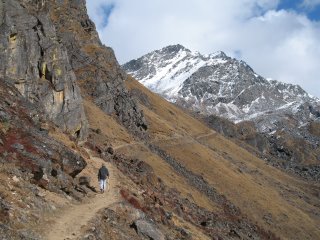
Fellow travellers, do well to be...
children of lofty spirit
answer the call of Mother Nepal,
come to the home of the Himalayas.
Expenditure
Return Air-ticket to Kathmandu by Royal Nepal Airlines - RM1592
Airport pickup to hotel - USD5
Nepal 60 day single entry visa - RM120
AIG Travel Insurance 20 days - RM83
Triple-bed Room at Hotel Harati, Thamel - US25 per day
Trekking fees (inclusive of Trekking Registration, accommodation, 3 meals/day, a guide and a porter) - USD300 per trekker
Maoist Tax - Rs1200 (RM60) for 12 days of trekking
Tips to guide & porter (each USD1/day/trekker, more on my part, for subjecting guide to gaseous intoxication)
Hot water/tea/hot chocolate at tea-houses - Rs50 to Rs140/cup (RM2.50 to RM7)
Return taxi-fare from Kathmandu to Patan - Rs320 (RM16)
Entrance fees to Patan City - Rs200 (RM10)
Entrance fees to Golden Temple - Rs25 (RM1.25)
Return taxi-fare from Kathmandu to Bouddhanath - Rs400 (RM20)
Entrance fees to Bouddhanath Stupa - Rs100 (RM5)
Airport Departure Tax - Rs1695 (RM84.75)
Menu prices at Thamel:
Small pot black coffee/tea - Rs80 (RM4)
Cup of ginger/lemon tea - Rs35 RM1.75)
Chicken noodle soup - Rs125(RM6.25)
Mixed chowmein - Rs65(RM3.25)
Vegetable soup - Rs40(RM2)
Continental breakfast - Rs85(RM4.25)
Chicken Briyani - Rs110(RM5.50)
Curd (yoghurt) - Rs60(RM3)
Masala Omelette - Rs65(RM3.25)
Croissant - Rs20(RM1)
See more photos at-
http://asia.pg.photos.yahoo.com/ph/yeohcweng/album?.dir=b267scd&.src=ph&store=&prodid=&.done=http%3a//asia.pg.photos.yahoo.com/ph/yeohcweng/
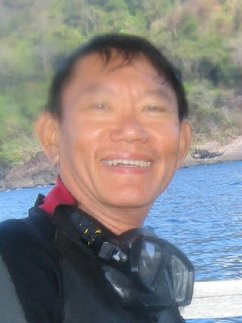

<< Home